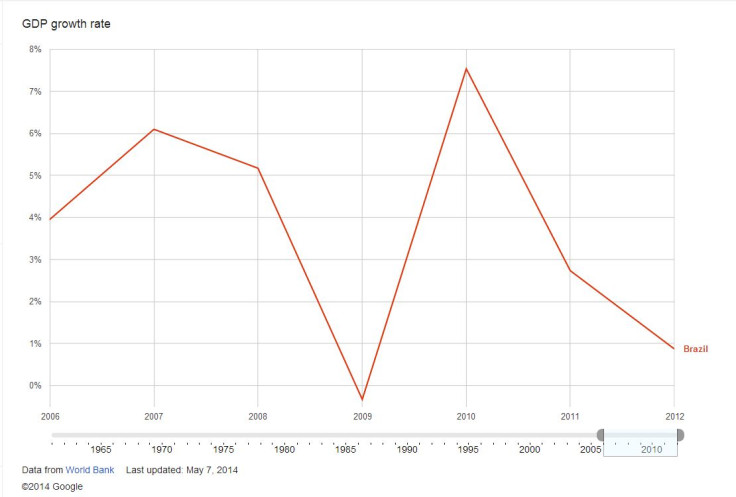What Were They Thinking? As World Cup Problems Compound, Brazil Prepares To Hold 2016 Olympics, Too

With the delays, protests, cost overruns, strikes and related problems in the run-up to Brazil’s hosting of the World Cup soccer championship, it should perhaps come as no surprise that a 46,000-seat stadium was built in a city that’s largely inaccessible by road and whose soccer team averages only 4,000 fans per game.
This is the Brazilian World Cup, after all. Much that has happened so far has made little sense. Manaus, a remote city deep in the Amazon, wanted an oversized stadium, and got it, at a cost of $270 million, out of a total of $11 billion that Brazil has spent so far on the preparations.
Never mind that the stadium will be used for only four World Cup games.
Most exceptionally large events -- and the World Cup is the largest sports event on earth, with almost 1 billion TV viewers -- involve cost overruns and claims of corruption, but Brazil has taken waste and poor planning to unprecedented levels. The nation last hosted a sporting event of that size in 1950, when the Cup wasn't even televised. This year, it can be argued that it gets to kickoff on Thursday as the least prepared nation among the 16 that have hosted the Cup. Airports are unfinished and hard to navigate; the threat of disruptive strikes and water and power shortages looms; the poor condition of the playing field in some stadiums -- including in Manaus -- may cause injuries to players; and a majority of Brazilians, after hundreds of thousands took to the streets in protest of spending too much money for the Cup, think it was a bad idea to organize it.
In short, the first World Cup to be held in the most soccer-crazed nation is risking disaster.
So what was the Olympic Committee thinking when it chose Brazil to host the 2016 games as well? Brazil will be the second country to get the events back to back, the first being the United States in 1994 and 1996.
The answer is that they were thinking primarily of the Brazilian economy, which was booming back in 2007, when it got the World Cup and decided to go for the Olympics. The country was flush with opportunities, and everyone wanted to ride the wave.
But it turns out a country’s economy is not necessarily a good predictor of its future capabilities. Since 2007, Brazil’s economy has collapsed, causing a number of complicating factors, not the least of which is that the government had to make up for millions of dollars in private investment that did not come through. Huge amounts of money that the country doesn’t have were thrown at the problem of preparing for the World Cup, at the expense of much-need social support programs. That, in turn, has led to sometimes violent protests.

“The criticism is, we could have done without the stadium in Manaus and other stadiums in small cities,” Paul Setero, director of the Brazil institute of the Woodrow Wilson International Center, told International Business Times. “FIFA [the world soccer governing body] told Brazil it should have only offered eight stadiums, but it was Brazil’s initiative to offer 12 because Brazil is the country of soccer and in 2007 the economy was going pretty well.”
In the mid-2000s, Brazilians had every reason to think the country could host both the World Cup and the Olympics. Then, at the end of 2008, after Brazil was awarded the Cup and was one year into its bid to host the Olympics, the economy collapsed. The resulting lack of private funding was exacerbated by deeply entrenched cultural norms regarding deadlines, the former Brazilian star striker Ronaldo observed to the newspaper O Globo.
"We leave everything to the last minute," Ronaldo said. "We've had since 2007 to get organized. We wouldn't be under such pressure today if we had."
The economic collapse came two years after the residents of Manaus received what was initially joyful news: that their Amazonian city, a 19th century rubber powerhouse now forgotten by most of the world, had been named one of 12 host cities for the soccer championship. Then, in 2009, as construction began on the new stadium, the Arena Amazonia, Brazil won the right to host the 2016 Olympics.
Since then, the Arena Amazonia has became symbolic of a country that that may have bitten off more than it could chew. Though the stadium is now complete, it will never be fully utilized, and massive infrastructure elsewhere in the country remains unfinished even as the championship begins. Notably, the 65,000-seat Itaquerao Stadium in São Paulo is unfinished, and making matters worse, the Brazilian economy appears to be headed for another contraction, according to Setero.
The Olympics are still two years away, but the preparation for that event is not faring much better. Only about 10 percent of the work has been done, Setero said. By comparison, Athens at this point in its preparations for the 2004 Olympics was at 40 percent completion and London was at 60 percent for the 2012 edition.
When the U.S. hosted the 1994 World Cup and the 1996 Atlanta Olympics, the country already had much of the infrastructure in place -- hotels, state-of-the-art stadiums, international airports and cities with the amenities necessary for a major influx of fans. The cost of hosting the World Cup was just $30 million, and the Atlanta Olympics came in at $1.8 billion.
The main reason Brazil believed it was capable of hosting both, Setero said, was its flush finances when the World Cup bidding process began in 2003. Its economy peaked in 2007 at around $2.7 trillion GDP, then one of the largest in the world.
“When the country won the World Cup,” Setero said, “it was welcomed. There was a suggestion it would produce positive outcomes in Brazil, especially an incentive to get going on infrastructure projects that were behind in cities across the country." Still, he echoed Ronaldo’s assessment about the country’s inefficiency. “The infrastructure delays are systemic of a much bigger problem that we have in the Brazilian economy that goes back decades,” he said. “It’s hard to get things done here.”
In 2003, FIFA was operating a rotational policy that would see the World Cup hosted in Europe every eight years, and on other continents every four. When FIFA announced that the 2014 World Cup would be hosted in South America after Africa in 2010, there were few realistic candidates. After early interest from Argentina and Colombia, the South American Football Federation put its full support behind Brazil, which formally bid in 2006 with no competition.
Eight years later, cities such as Manaus, Natal and Cuiaba all have stadiums exceeding 40,000 seats, though the teams that will use the stadiums after the World Cup only average about 4,000 people per game -- far lower than the national average of 14,000 for teams in Brazil’s top division.
© Copyright IBTimes 2024. All rights reserved.





















